Hairtail - see Belt Fish.
Halibut - see Flounders,
righteye
Herring
- [Family Clupea, various genera and species]
A family of generally small oily fish, Herring can grow to over 18 inches
and 1.5 pounds but is generally caught and harvested much smaller.
See also Sardine
|
Atlantic Herring - [Clupea harengus harengus]
 The most abundant and economically important herring, this round bodied
fish can grow to nearly 18 inches and 1.5 pounds but is most often harvest
in smaller sizes. The photo example was probably about 8-1/2 inches when it
had it's head on, but it's now pickled. Sorry, but that's as close as I could
get to an Atlantic herring right now.
The most abundant and economically important herring, this round bodied
fish can grow to nearly 18 inches and 1.5 pounds but is most often harvest
in smaller sizes. The photo example was probably about 8-1/2 inches when it
had it's head on, but it's now pickled. Sorry, but that's as close as I could
get to an Atlantic herring right now.
Atlantic herring is commonly sold smoked or pickled but is eaten raw in
Holland and fresh in Northern Europe, particularly Poland. Whitebait are
immature herrings and generally eaten whole. Sild are small immature
herrings canned like Sardines in Norway. Marine ecologists classify
Atlantic herring as a sustainable harvest.
Herring Pickled, Canned, Kippered & Dried
 Herring is an oily fish that preserves well in various ways, and all these
ways are exploited. The photo shows two varieties of pickled herring from
Poland, a major herring eating country. Yummm!
More on Preserved Herring
Herring is an oily fish that preserves well in various ways, and all these
ways are exploited. The photo shows two varieties of pickled herring from
Poland, a major herring eating country. Yummm!
More on Preserved Herring
Toli Shad - [Chinese Herring,
Tenualosa toli]
 A highly commercial Indo-West Pacific herring found from the Bay of Bengal
to the South China Sea and the Java Sea, these fish can grow to 23 inches
but the specimen in the photo was 9-3/4 inches and weighed 5 ounces.
Toli Shad is marketed fresh and dried and is not considered threatened.
Prep & Cooking Details
A highly commercial Indo-West Pacific herring found from the Bay of Bengal
to the South China Sea and the Java Sea, these fish can grow to 23 inches
but the specimen in the photo was 9-3/4 inches and weighed 5 ounces.
Toli Shad is marketed fresh and dried and is not considered threatened.
Prep & Cooking Details
Tunsoy - [Genus Sardinella various species
and Dussumieria acuta]
 Tunsoy is the Philippine name for various Indo-Pacific herring. The photo
example was rehydrated from a package of salted and dried herring obtained
from a Philippine grocery. These fish are about 5-1/2 inches long and weigh
about 1/2 ounce (after a 5 hour soak).
Prep & Cooking Details
Tunsoy is the Philippine name for various Indo-Pacific herring. The photo
example was rehydrated from a package of salted and dried herring obtained
from a Philippine grocery. These fish are about 5-1/2 inches long and weigh
about 1/2 ounce (after a 5 hour soak).
Prep & Cooking Details
|
Idiot Fish - See Rock Fish - Idiot.
Jacks
- [Genus Caranx, various species]
A family of deep bodied fish related to Pompanos and Scads.
|
Blue Runner - [Bluestripe Jack, Hardtail Jack,
Caranx crysos]
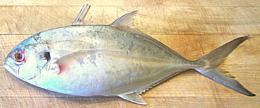 Belonging to the same family as Pompanos, Blue Runners are found on both
sides of the Atlantic and in the Mediterranean, generally near reefs, They
can grow to 27 inches and 11 pounds, but the photo specimen, caught wild off
Alabama, was 13 inches and weighed 1# 2 oz.
Prep & Cooking Details
Belonging to the same family as Pompanos, Blue Runners are found on both
sides of the Atlantic and in the Mediterranean, generally near reefs, They
can grow to 27 inches and 11 pounds, but the photo specimen, caught wild off
Alabama, was 13 inches and weighed 1# 2 oz.
Prep & Cooking Details
Crevalle Jack - [Jackfish
Caranx caninus (Pacific) Caranx hippos (Atlantic)]
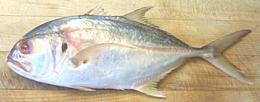 The Pacific and Atlantic fish may actually be the same species. The Pacific,
is found from Southern Californa to Peru and may grow to almost 40 inches
and almost 40 pounds but the photo specimen is 11 inches and 11 ounces.
Atlantic fish are found from Nova Scotia to Uruguay and have grown to over
48 inches and 70 pounds.
Prep & Cooking Details
The Pacific and Atlantic fish may actually be the same species. The Pacific,
is found from Southern Californa to Peru and may grow to almost 40 inches
and almost 40 pounds but the photo specimen is 11 inches and 11 ounces.
Atlantic fish are found from Nova Scotia to Uruguay and have grown to over
48 inches and 70 pounds.
Prep & Cooking Details
Yellowtail Amberjack - [California Yellowtail,
Seriola lalandi]
 This large jack is found in warm waters all around the Pacific, the
Pacific Islands and the South Atlantic below the Equator. This is a prize game
fish off the coast of California and can grow to over 8 feet long and over
200 pounds but the photo specimen was 27 inches and 7.44 pounds.
Prep & Cooking Details
This large jack is found in warm waters all around the Pacific, the
Pacific Islands and the South Atlantic below the Equator. This is a prize game
fish off the coast of California and can grow to over 8 feet long and over
200 pounds but the photo specimen was 27 inches and 7.44 pounds.
Prep & Cooking Details
Lingcod - [Ophiodon elongatus]
The only representative of genus Ophiodon, the Lingcod is not a
cod. It's found on the Pacific coast of North America from Ensenada, Mexico
to the Gulf of Alaska and is considered an excellent eating fish. Lingcod
can grow to nearly 60 inches and 130 pounds.
Mackerel
Mackerels are a large family (Scombridae) of meaty, oily and
strongly flavored fish.
- Atlantic Mackerel -
[Scomber scombrus]
The presumed mackerel in most mackerel recipes - medium flavor.
- Chub Mackerel - see Japanese Mackerel
- Hasa Hasa (Phillipine) - [Short Mackerel
(fb) Rastrelliger brachysoma]
Fish seen marketed as "Hasa Hasa" in Los Angeles are actually Bigeye Scad.
- Indian Mackerel - [Rastrelliger
kanagurta ]
A small highly commercial Indo-West Pacific mackerel.
- Japanese Mackerel - [Blue Mackerel, Pacific
Mackerel, Chub Mackerel, Aji (Japanese), Scomber japonicus]
A fairly strong flavored mackerel found worldwide.
- King Mackerel -
[Scomberomorus cavalla]
Largest of the fish called mackerel, grows to100 pounds and up to 6 feet.
- Mackerel Pike - [Pacific Saury,
Sanma (japanese), Cololabis saira]
A small thin fish from the North Pacific.
- Pacific Sierra -
[Sierra, Spanish Mackerel, Scomberemorus sierra]
A good eating mackerel popular raw in sushi bars as Spanish Mackerel.
- Smoked Mackerel
Mackerel is an excellent candidate for smoking.
Mahi-Mahi - [Dolphin, Dolphin-fish,
Dorado Coryphaena hippurus]
This large fish is unrelated to the sea mammal also called "Dolphin" so
the Hawaiian name Mahi-Mahi is now widely used to avoid confusion. They are
a short lived fish and are usually caught at about 20 pounds, though they
can grow to 90 pounds. The flesh is firm and generally cut into steaks and
is often used as a kosher substitute for swordfish,
Milkfish - [Bangus (Philippine),
Chanos chanos]
 This Indo-Pacific warm water fish is an important food fish in India,
Southeast Asia and the Pacific, particularly the Philippines. Milkfish are
extremely suspicious, strong and very fast so are difficult to catch in the
wild but are a major farm fish in many tropical counties. While they can grow
to almost 6 feet and over 30 pounds, farmed milkfish is generally marketed at
18 inches and smaller The fish in the photo was 18 inches and 2-1/4 pounds.
The milkfish is durable, having survived the Cretaceous extinction that did
in the dinosaurs, the amonites and perhaps 50% of other marine species.
Prep & Cooking Details
This Indo-Pacific warm water fish is an important food fish in India,
Southeast Asia and the Pacific, particularly the Philippines. Milkfish are
extremely suspicious, strong and very fast so are difficult to catch in the
wild but are a major farm fish in many tropical counties. While they can grow
to almost 6 feet and over 30 pounds, farmed milkfish is generally marketed at
18 inches and smaller The fish in the photo was 18 inches and 2-1/4 pounds.
The milkfish is durable, having survived the Cretaceous extinction that did
in the dinosaurs, the amonites and perhaps 50% of other marine species.
Prep & Cooking Details
Monkfish - [Angler, Lophius
americanus (North America), Lophius piscatorius (Europe)]
Monkfish is mostly a huge ugly inedible head with a small tail
sticking out the back side of it. This explains why you'll never see a whole
monkfish in the fish market - only the tail is sold. The American Monkfish
can grow to 47 inches and 57 pounds, the European to 78 inches and 127 pounds
but these figures are meaningless since most of the fish is inedible.
Monkfish is not kosher. The European Monkfish is considered heavily
overfished though not yet on the official endangered lists.
Prep & Cooking Details
Moonfish - [Mexican Moonfish,
Selene orstedii]
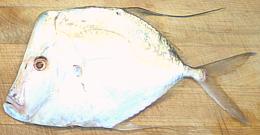 Related to Pompanos, this fish is found on the East Pacific coast from Baja
California to Columbia in South America. They can grow to 13 inches long but
the ones available commercially here are about 10 inches and weigh about
9 ounces. Not listed as threatened.
Related to Pompanos, this fish is found on the East Pacific coast from Baja
California to Columbia in South America. They can grow to 13 inches long but
the ones available commercially here are about 10 inches and weigh about
9 ounces. Not listed as threatened.
Mullet - [Family
Mugilidae]
A fairly large family of salt water fish, Mullets have always been very
popular in the Mediterranean area and costal Europe but is little used in
North America. Confusingly, the best know "mullet", the Red Mullet, is not
a mullet at all but a Goatfish.
|
Grey Mullet - [Flathead Mullet,
Mugil cephalus]
 Found world wide except in the Caribbean, this fish can grow to 47 inches and
26 pounds but the specimen in the photo is 15 inches and 1-1/4 pounds.
They are caught wild and farmed and are not considered threatened. They are
not often seen U.S. stores but are a very important commercial fish in many
parts of the world - look for them in Asian groceries.
Prep & Cooking Details.
Found world wide except in the Caribbean, this fish can grow to 47 inches and
26 pounds but the specimen in the photo is 15 inches and 1-1/4 pounds.
They are caught wild and farmed and are not considered threatened. They are
not often seen U.S. stores but are a very important commercial fish in many
parts of the world - look for them in Asian groceries.
Prep & Cooking Details.
|
Orange Roughy - [Hoplostethus
atlanticus]
A fish caught in extremely deep water, mainly off New Zealand. The fishery
started in 1979 when gear was made available that could locate and catch
them at such depth. They are extremely long lived (to 150 years) slow
breeding fish and even at current reduced rates the fishery is probably not
sustainable. Rated "Do Not Eat" by marine environmentalists. Average
market size is about 2-1/4 pounds and they are so ugly they're always sold
as fillets. The flesh is mild, almost shellfish like and has been compard
to sole.
Patagonian Toothfish -
[Chilean Sea Bass, Merluza Negra (spanish), Mero (japan) Dissostichus
eleginoides]
A large fish (up to 250 pounds) living at great depths in the
southern oceans from Uruguay to the Antarctic Circle. It has very white
flesh with a high fat content but rather little flavor. A single large fish
can sell for $1000 in Japan. Though marketed as "Chilean Sea Bass" in the
U.S. it is not a bass at all nor is it specific to Chile.
This fish is endangered by pirate fishing and it's slow rate of
maturing.
Perch [Genus
Perca species]
"Perch" is the prototype for Order Perciformes (Perch-like fishes)
to which most of our familiar fish belong.
Petrale Sole - see Flounders
Pollock - [Theragra species
(Alasakan, Norwegian), Pollachius species (true pollocks)]
 The Alaskan Pollock [walleye pollock T. chalcogramma] is the
largest fish harvest in the world at 3 million tons per year. Most is made
into sirimi, artificial crab meat, and McDonald's fish sticks. Alaskan Pollock
is in the same family (Gadidae) as Cod and is considered a
sustainable catch by marine ecologists.
Prep & Cooking Details.
The Alaskan Pollock [walleye pollock T. chalcogramma] is the
largest fish harvest in the world at 3 million tons per year. Most is made
into sirimi, artificial crab meat, and McDonald's fish sticks. Alaskan Pollock
is in the same family (Gadidae) as Cod and is considered a
sustainable catch by marine ecologists.
Prep & Cooking Details.
Pomfret - [Family Bramidae
various genera and species]
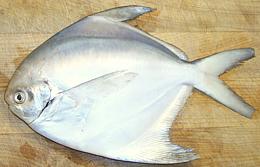 Pomfret come in White (silver) and Gray. The photo is of a Silver Pomfret
Pampus argenteus. The white is considered superior but the gray or
(black pomfret is actually a pompano. Pomfrets have a
diamond shape profile and run about a half pound in Asian groceries here
in Los Angeles, though I understand they can get up to about a pound.
Some species in the wild can get up to 30 inches.
Prep & Cooking Details.
Pomfret come in White (silver) and Gray. The photo is of a Silver Pomfret
Pampus argenteus. The white is considered superior but the gray or
(black pomfret is actually a pompano. Pomfrets have a
diamond shape profile and run about a half pound in Asian groceries here
in Los Angeles, though I understand they can get up to about a pound.
Some species in the wild can get up to 30 inches.
Prep & Cooking Details.
Pomfret, Black - [C.
Parastromateus niger]
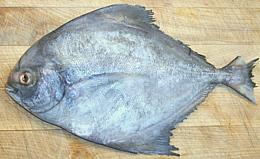 Actually not a Pomfret but a Pompano (the two families look a lot alike) but
a very good eating fish anyway.
Prep & Cooking Details.
Actually not a Pomfret but a Pompano (the two families look a lot alike) but
a very good eating fish anyway.
Prep & Cooking Details.
Pompanos
- [Genus Trachinotus, Parastromateus and others]
Deep bodied ocean fish of family Carangidae (Jacks and Pompanos).
- Black Pomfret - [C.
Parastromateus niger]
Actually not a Pomfret but a Pompano.
- Pompano - [Trachinotus blochii
(Golden Pompano, Asian Pompano), Trachinotus carolinus (Florida
Pompano, Common Pompano)]
A highly preferred eating fish.
Pony Fish - [Leiognathus
equulus]
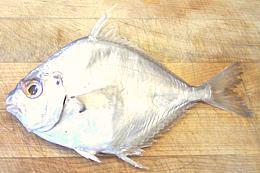 This tropical Indo-Pacific fish is found from the east coast of Africa
to the Pacific Islands and as far south as the north coast of Australia.
The fish gets its name from its strange extensible mouth which looks
like a pony's nose when extended.
This tropical Indo-Pacific fish is found from the east coast of Africa
to the Pacific Islands and as far south as the north coast of Australia.
The fish gets its name from its strange extensible mouth which looks
like a pony's nose when extended.
Pony Fish can grow to 11 inches but the photo specimen was 9-1/2 inches
and weighed 9 oz, caught wild off Thailand. Living near river mouths and in
mangrove areas they are both farmed and caught wild and sold both fresh and
dried. They are not considered threatened.
Prep & Cooking Details.
Porgy -
[family Sparidae]
Various deep bodied fish that subsist mainly by crushing shellfish.
Familiar on the U.S. east coast are Pagrus pagrus, caught mostly off
New England and Sheepshead Porgy caught south of the Chesapeake Bay. Most
familiar in Europe is the Red Porgy or Red Sea Bream. Porgy is not well
known on the U.S. West Coast because the Pacific Porgy is rare of Southern
California, becoming common off the coast of Mexico.
|
Squirefish - [Pink Snapper,
Chrysophrys auratus]
 A fish often sold in the U.S. as "Snapper" from New Zealand, this
Porgy is found of the coasts of Australia and New Zealand. A distinctly
separate population is found from the Philippines and Indonesia to
China, Taiwan, and Japan. Farming this fish is in the experimental stages
so all market fish are currently wild. The pictured specimen was 14 inches
long and weighed 1 pound 6 ounces. The Squirefish is not considered
threatened.
Prep & Cooking Details.
A fish often sold in the U.S. as "Snapper" from New Zealand, this
Porgy is found of the coasts of Australia and New Zealand. A distinctly
separate population is found from the Philippines and Indonesia to
China, Taiwan, and Japan. Farming this fish is in the experimental stages
so all market fish are currently wild. The pictured specimen was 14 inches
long and weighed 1 pound 6 ounces. The Squirefish is not considered
threatened.
Prep & Cooking Details.
|
Pufferfish - see FUGU.
Rabbit Fish - [Streaked spinefoot
(FDA), Java Rabbitfish, Siganus javus]
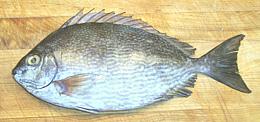 Found in tropic seas from the Persian Gulf to the South Pacific, the
Java Rabbitfish lives on algae. It reproduces quickly and is not listed
as endangered. It can grow to 20 inches but is generally marketed at 10 to
15 inches, roughly 12 oz to 2 pounds.
Prep & Cooking Details.
Found in tropic seas from the Persian Gulf to the South Pacific, the
Java Rabbitfish lives on algae. It reproduces quickly and is not listed
as endangered. It can grow to 20 inches but is generally marketed at 10 to
15 inches, roughly 12 oz to 2 pounds.
Prep & Cooking Details.
Rex Sole - see Flounders.
Ribbon Fish - see Belt Fish.
Rock Cod, Red - see Vermillion Rockfish.
Rock Cod (true) - [Lotella rhacina]
Members of the cod family (Gadidae) living mainly off the
coasts of Australia and New Zealand.
Rockfish, Scorpionfish
- [Pacific Rockfish, family Scorpaenidae, family Sebastidae]
Some biologists lump all these fish under Scorpaenidae
(Scorpionfishes) and some assign a number of genera to Sebastidae, a
family not recognized at all by the first group. They are mostly venomous
(poisoned spines) ranging from extremely to not much. Fortunately those
off the Pacific coast of California fall in the "not much" range.
Popularly, rockfish are called names like "Sculpin" and "Rock Cod" but
none are members of those families. They are popular eating fish ranging from
mid-Baja California to Kodiak Island Alaska, though each species has a more
limited range.
|
Idiot Fish -
[Shortspine Thornyhead, Sebastolobus alascanus]
 A variety of Scorpion Fish particularly
adapted to the "oxygen minimum" layer of the ocean where most fish can not
thrive. It lives in the North Pacific, some as far south as the Mexican border
but mostly Northern California, Washington State, Canada and Russia. The
individual in the photo was 18-1/2" long and weighed 2.69#.
A variety of Scorpion Fish particularly
adapted to the "oxygen minimum" layer of the ocean where most fish can not
thrive. It lives in the North Pacific, some as far south as the Mexican border
but mostly Northern California, Washington State, Canada and Russia. The
individual in the photo was 18-1/2" long and weighed 2.69#.
Living under very suboptimal conditions the Idiot Fish has a slow
propagation rate and is regulated to control overfishing, consequently it's
not common in the markets. Of course it's strange spiny appearance is sort
of off-putting for many people anyway, which is just as it should be because
there will be more left for me.
Prep & Cooking Details.
Vermillion Rockfish -
[Red Rock Cod, Sebastes miniatus]
 One of the many varieties of deep water rockfish caught all along the Pacific
coast from Baja to Vancouver Island. They can grow to 30 inches and 15 pounds
but the individual in the photo is normal market size at 17 inches and
3 pounds.
Prep & Cooking Details.
One of the many varieties of deep water rockfish caught all along the Pacific
coast from Baja to Vancouver Island. They can grow to 30 inches and 15 pounds
but the individual in the photo is normal market size at 17 inches and
3 pounds.
Prep & Cooking Details.
|
Sablefish - [Black Cod,
Anoplopoma fimbria]
 This ugly fish is currently the darling of the fancy restaurant chefs under
the name "black cod". Sablefish are found off the North Pacific coast in
deep sandy water, ranging from mid Baja California all the way around to mid
China though it's scarce south of Los Angeles and Korea. The one in the photo
is 23 inches and weighed a couple ounces under 3 pounds.
This ugly fish is currently the darling of the fancy restaurant chefs under
the name "black cod". Sablefish are found off the North Pacific coast in
deep sandy water, ranging from mid Baja California all the way around to mid
China though it's scarce south of Los Angeles and Korea. The one in the photo
is 23 inches and weighed a couple ounces under 3 pounds.
Sablefish farming is now being developed in Canada to the
intense distress of the wild catch industry. The Sablefish fishery
is highly regulated in both the U.S. and Canada to assure a sustainable
harvest.
Prep & Cooking Details.
Salay Salay - Philippine - a number of small deep bodied Scad
varieties - see Yellowstripe
Scad Alepes melanoptera, Blackfin Scad Alepes
melanoptera, Herring Scad Alepes vari, Shrimp Scad Alepes
djedaba,
SALMON -
[Family Salmonidae, Genus Oncorhynchus (Pacific) and
Salmo (Atlantic) species]
 Salmon are large seagoing Trout. Actually all Trout are Salmonidae but we've
broken out those not called Salmon to a Trout heading
for clarity, Salmon live most of their lives in the deep oceans but return
to the river of their birth to spawn - and then die. Why they die I do not
know, other fish of the same genus, even seagoing ones, survive spawning
(so are classed as Trout). Atlantic salmon have a high mortality at spawning
but some survive.
Salmon are large seagoing Trout. Actually all Trout are Salmonidae but we've
broken out those not called Salmon to a Trout heading
for clarity, Salmon live most of their lives in the deep oceans but return
to the river of their birth to spawn - and then die. Why they die I do not
know, other fish of the same genus, even seagoing ones, survive spawning
(so are classed as Trout). Atlantic salmon have a high mortality at spawning
but some survive.
Salmon Details
Sand Dab - See Flounders.
Sandfish -
[Sailfin Sandfish, Arctoscopus japonicus]
 This fish is found in sandy-muddy bottom areas of the Asian side of the North
Pacific. In Japan these fish are cultured in captivity, then released for the
fishery. They grow to as long as 11 inches and 7 ounces. The photo specimen
was by far the largest from a tray of frozen fish purchased from a Korean
grocery and was 10 inches long and just over 4 oz.
Prep & Cooking Details.
This fish is found in sandy-muddy bottom areas of the Asian side of the North
Pacific. In Japan these fish are cultured in captivity, then released for the
fishery. They grow to as long as 11 inches and 7 ounces. The photo specimen
was by far the largest from a tray of frozen fish purchased from a Korean
grocery and was 10 inches long and just over 4 oz.
Prep & Cooking Details.
Sardine - [Herring family
Clupeidae]
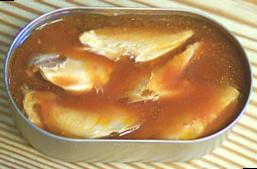 There are many varieties of Sardine, all members of the
Herring Family, and each variety is likely to be
known by a number of local names. Larger fish may be sold fresh but
many millions are canned every year, packed in water, oil, mustard sauce and
tomato sauce, particularly in Canada, Southeast Asia and Morocco (the largest
producer).
There are many varieties of Sardine, all members of the
Herring Family, and each variety is likely to be
known by a number of local names. Larger fish may be sold fresh but
many millions are canned every year, packed in water, oil, mustard sauce and
tomato sauce, particularly in Canada, Southeast Asia and Morocco (the largest
producer).
My preference is for Canadian, followed by Southeast Asian and
with Moroccan a distant third. The photo shows a short stubby variety from
Thailand canned in tomato sauce.
|
California Sardine - [South American Pilchard,
Sardinops sagax]
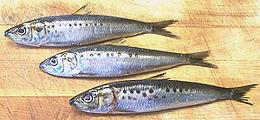 California is fortunate in having a good supply of these sardines sold fresh,
but they are also found along both Pacific coasts, in the Indian Ocean and
on the Atlantic side of South Africa. The photo specimens are about 7 inches
long and weigh about 2 ounces each.
Prep & Cooking Details.
California is fortunate in having a good supply of these sardines sold fresh,
but they are also found along both Pacific coasts, in the Indian Ocean and
on the Atlantic side of South Africa. The photo specimens are about 7 inches
long and weigh about 2 ounces each.
Prep & Cooking Details.
|
Saury, Pacific Saury - see Mackerel Pike.
Sild - see Herring.
Scabbard Fish - see Belt Fish.
Scad - [family Carangidae]
When you see Scad, think of "mackerel", even though they aren't related.
Scad belong to the same family as the mild and delectable Pompanos, but
they resemble mackerel in a similar robust flavor, but without the oil.
|
Mackerel Scad - [Round Scad, Decapterus
macarellus]
 This fish is not related to Mackerel, but can be treated similarly except
when the Mackerel's oiliness is important (smoking, pickling). The
specimen in the photo was 15 inches long and weighed 1# 3oz. These fish have
largish scales, but only up at the head end.
Prep & Cooking Details.
This fish is not related to Mackerel, but can be treated similarly except
when the Mackerel's oiliness is important (smoking, pickling). The
specimen in the photo was 15 inches long and weighed 1# 3oz. These fish have
largish scales, but only up at the head end.
Prep & Cooking Details.
Round Scad - a group of mackerel shaped scads,
all of the genus Decapterus, including Mackerel Scad
(D. macarellus), Japanese Scad (D. maruadsi),
Shortfin Scad (D. macrosoma), Round Scad
(D. punctatus) and Indian Scad (D. russelli).
Shortfin Scad - [Round Scad, Decapterus
macrosoma]
 This Indo-Pacific scad is also found in the East Pacific from the coast of
Baja California to Northern Peru. They can grow to over 14 inches, but the
ones popular here (photo - California wild caught) are about 6-1/2 inches
and weigh 2 ounces.
Prep & Cooking Details.
This Indo-Pacific scad is also found in the East Pacific from the coast of
Baja California to Northern Peru. They can grow to over 14 inches, but the
ones popular here (photo - California wild caught) are about 6-1/2 inches
and weigh 2 ounces.
Prep & Cooking Details.
Yellowstripe Scad - [Salay Salay, Alepes
melanoptera]
 One of a number of similar small deep bodied Scad called "Salay Salay" in
the Philippines. These Indo-Pacific fish, found from the Persian Gulf to
the Philippines, can reach 8 inches but are marketed here much smaller.
The photo specimen is 5-1/2 inches long and weighs 1 ounce.
Prep & Cooking Details.
One of a number of similar small deep bodied Scad called "Salay Salay" in
the Philippines. These Indo-Pacific fish, found from the Persian Gulf to
the Philippines, can reach 8 inches but are marketed here much smaller.
The photo specimen is 5-1/2 inches long and weighs 1 ounce.
Prep & Cooking Details.
Yellowtail Scad - [Atule mate]
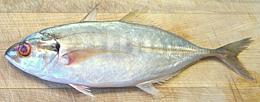 This Indo-Pacific fish is found from the east coast of Africa to Hawaii.
The specimen in the photo was 11 inches and weighed 9 ounces.
Prep & Cooking Details.
This Indo-Pacific fish is found from the east coast of Africa to Hawaii.
The specimen in the photo was 11 inches and weighed 9 ounces.
Prep & Cooking Details.
|
Scorpionfish - see Rockfish.
Sculpin - see Rockfish.
Sea Bream - [family Sparidae (most), family
Lethrinidae, others]
A catch-all name for a number of deep bodied fish of various names
that resemble fresh water bream. Most of them are Sparidae
(Porgies) or Lethrinidae (Emperors) but other
families are represented.
Shark -
[class Chondrichthyes subclass Elasmobranchii superorder
Selachimorpha]
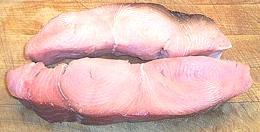 Sharks are very different from other fish. When the modern fish (teleosts
- bony fish) came on the scene they rapidly pushed their predecessors toward
extinction. Under severe stress these fish back evolved some
primitive features of their own predecessors. So successful was this
adaption following era is called the "Age of Sharks".
Sharks are very different from other fish. When the modern fish (teleosts
- bony fish) came on the scene they rapidly pushed their predecessors toward
extinction. Under severe stress these fish back evolved some
primitive features of their own predecessors. So successful was this
adaption following era is called the "Age of Sharks".
Sharks have much larger brains than modern fish, no bones but a skeleton
of cartilage and their scales are formed like teeth rather than the removable
flakes on modern fish (thus shark is not kosher). In the U.S. shark is
generally marketed as thick steaks like these 1-1/2 inch thick thresher
shark steaks from Costa Rica.
Prep & Cooking Details.
Skate - [family Rajidae]
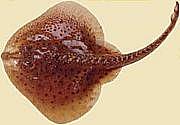 These bottom dwelling fish are related to sharks but have pectoral fins so
enlarged they are referred to as "wings" a characteristic they share with
Rays. Like sharks skates have no bones but a skeleton of cartilage. Skate
is generally sold as cuts from the wings and is prepared quite differently
from other fish. Skate wing can be found in Asian fish markets or fish
markets near fishing ports.
These bottom dwelling fish are related to sharks but have pectoral fins so
enlarged they are referred to as "wings" a characteristic they share with
Rays. Like sharks skates have no bones but a skeleton of cartilage. Skate
is generally sold as cuts from the wings and is prepared quite differently
from other fish. Skate wing can be found in Asian fish markets or fish
markets near fishing ports.
Some skates are listed as endangered (Common Skate, Thornback and Roker)
but it's impossible to tell in the market what skate they are selling.
Prep & Cooking Details.
Smelt - [family Osmeridae,
several genera]
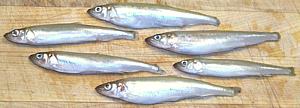 Small fish related to Salmon and found in both salt water and fresh (where
they spawn in streams). Various species are native to Atlantic and Pacific
coasts of the U.S. and Canada, some as far south as Southern California but
most in northern waters. Smelt are also found along the coasts of Europe
and the western Pacific. A variety native to the U.S. northeast coast was
introduced to the U.S. Great Lakes in about 1918 and became an important
catch there, but the population is currently in decline.
Small fish related to Salmon and found in both salt water and fresh (where
they spawn in streams). Various species are native to Atlantic and Pacific
coasts of the U.S. and Canada, some as far south as Southern California but
most in northern waters. Smelt are also found along the coasts of Europe
and the western Pacific. A variety native to the U.S. northeast coast was
introduced to the U.S. Great Lakes in about 1918 and became an important
catch there, but the population is currently in decline.
Smelt form large schools and are harvested in both open waters and in
spawning streams. They are generally marketed at 6 to 8 inches, most being
frozen and bagged. Bright orange smelt roe is collected from fish caught
in the spawning streams and sold to garnish sushi.
Prep & Cooking Details.
Snakehead - [Mudfish, Dalag (phil.),
Snakehead murrel, Channa striata]
 This is one of the most important food fish in Thailand, Vietnam and
Malasia, both wild and farmed, and is also popular in the Philippines. Live
snakehads are popular in Asia but are illegal in the U.S. (but Asians keep
sneaking them in). They can grow to 40 inches (larger in Hawaii) and 6.6
pounds but the photo specimen was 17 inches and 1-1/2 pounds. A fresh water
fish preferring muddy water, like the walking
catifish it can survive extreme conditions and take off over land to
exploit new ponds and rivers. Like the walking catfish It's a voracious
predator but can survive in colder climates.
Prep & Cooking Details.
This is one of the most important food fish in Thailand, Vietnam and
Malasia, both wild and farmed, and is also popular in the Philippines. Live
snakehads are popular in Asia but are illegal in the U.S. (but Asians keep
sneaking them in). They can grow to 40 inches (larger in Hawaii) and 6.6
pounds but the photo specimen was 17 inches and 1-1/2 pounds. A fresh water
fish preferring muddy water, like the walking
catifish it can survive extreme conditions and take off over land to
exploit new ponds and rivers. Like the walking catfish It's a voracious
predator but can survive in colder climates.
Prep & Cooking Details.
Snappers -
[family Lutjanidae (Snappers)]
|
Red Snapper
Lots of fish are marketed under the name "Red Snapper", but some aren't
even in the family Lutjanidae and some aren't even red. Listed here
are some with a legitimate claim to the name.
Crimson Snapper - [Lutjanus erythropterus]
This is what an Australian would probably have in mind as a Red Snapper.
This species inhabits the Indo-Pacific region and is both caught commercially
and farmed. to 32 inches. Not considered threatened.
Jordan's Snapper - [Lutjanus jordani]
Mexico to Peru 23 inches Not considered threatened
New Zealand Snapper - Pink Snapper - see
Squirefish This fish often sold in the U.S. as
"Snapper" from New Zealand is actually a Porgy.
Northern Red Snapper - [Lutjanus
campechanus]
This popular fish is found in the Gulf of Mexico and off the Western
Atlantic coast to Massachusetts but is rare above North Carolina. It can
grow to 39 inches and 48 pounds. There have been reports of
ciguatera poisoning from eating fish
from tropical reef environments. The body of this fish is deeper than
the Pacific Red Snapper and the face more tapered to a point. This fish is
not considered threatened.
Pacific Red Snapper - [Lutjanus peru]
 These true Red Snappers are found from Mexico to Peru in the Eastern
Pacific. They can get up to 37 inches long and up to almost 13 pounds but
the market size example in the photo was 13 inches and weighed just over
1 pound.
Prep & Cooking Details.
These true Red Snappers are found from Mexico to Peru in the Eastern
Pacific. They can get up to 37 inches long and up to almost 13 pounds but
the market size example in the photo was 13 inches and weighed just over
1 pound.
Prep & Cooking Details.
Southern Red Snapper - [Lutjanus purpureus]
Caribbean to northern Brazil 39 inches 22 pounds
Not considered threatened.
|
Sole - [Common sole, Solea solea]
"Sole" without a qualifier means Common Sole, the Europen sole also known
as "Dover Sole". See Dover Sole for a full
explanation of the marketing subtrifuge created over this name. While there
are other soles Common sole is most common and preferred when available. It's
actually a worldwide fish, not just European, but is very rare on the Pacific
coast of North and South America, As a substitute use
Petrale Sole (actually a flounder).
Sprats - [family Clupeidae
(herring family) Spratus spratus]
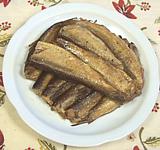 This small fish is a little slimmer than the herring and is particularly
important to the economies of Poland, Lithuania, Estonia and Latvia.
This small fish is a little slimmer than the herring and is particularly
important to the economies of Poland, Lithuania, Estonia and Latvia.
Sprats are smoked, beheaded (to fit in the can better) and
packed with sunflower seed oil and salt in 4" diameter by 1" high cans for
the enjoyment of persons of taste. Definitely not for the baby spinach set,
they go exceptionally well with ice cold vodka and strong Russian tea.
Fortunately plenty are now exported to the U.S. and I have a good stock
stashed away.
Swordfish - [Xiphias gladius]
 A large, ferocious predatory fish that uses it's long sharp beak as
a weapon to spear prey, which includes even Orcas, and to defend against
Maco Sharks, the only predator big enough, fast enough and ferocious enough
to take on a swordfish. They grow to 14 feet and over 1000 pounds.
Swordfish are not considered an endangered species.
Prep & Cooking Details.
A large, ferocious predatory fish that uses it's long sharp beak as
a weapon to spear prey, which includes even Orcas, and to defend against
Maco Sharks, the only predator big enough, fast enough and ferocious enough
to take on a swordfish. They grow to 14 feet and over 1000 pounds.
Swordfish are not considered an endangered species.
Prep & Cooking Details.
Tilapia - [Nile Tilapia,
Oreochromis niloticus niloticus]
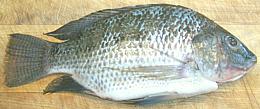 This fish native to the Nile can grow to 23 inches but is generally marketed
here at about 12 inches and 1-1/4 pounds like the photo specimen, Tilapia
was already being farm raised in Egypt probably over 4000 years ago. It has
since been transported to fresh water rivers and lakes in many countries.
Tolerant of water quality, fast growing, cheap to feed and tasty to eat,
Tilapia is an ideal aquaculture fish for warmer climates and is produced
in great quantity in Southern California and Arizona, but most still comes
from Mexico and South America..
Prep & Cooking Details.
This fish native to the Nile can grow to 23 inches but is generally marketed
here at about 12 inches and 1-1/4 pounds like the photo specimen, Tilapia
was already being farm raised in Egypt probably over 4000 years ago. It has
since been transported to fresh water rivers and lakes in many countries.
Tolerant of water quality, fast growing, cheap to feed and tasty to eat,
Tilapia is an ideal aquaculture fish for warmer climates and is produced
in great quantity in Southern California and Arizona, but most still comes
from Mexico and South America..
Prep & Cooking Details.
Tra - See Vietnamese Catfish.
Trout -
[family Salmonidae Genus Salmo (Atlantic), Oncorhynchus
(Pacific) and Salvelinus (Char and brook trout) species]
Trout really belong under the Salmon heading, but
salmon known as such are so important we've broken the two groups apart
for clarity. Seagoing fish that return to the rivers to spawn and then
die are classified as Salmon, those that survive are classified as Trout.
For other members of the Salmon family, see Whitefish
and Graylings.
|
Rainbow Trout [Steelhead Trout, Oncorhynchs
mykiss]
 Steelhead was reclassified from Salmo to Oncorhynchs in 1989,
so is now officially a Pacific Trout. All steelhead are hatched as Rainbow
Trout. Some individuals remain rainbow trout all their lives but others,
even from the same batch of eggs, only for one or two years, then
lose their rainbow coloring and head out to sea. A year or more later they
return to the river of their birth to spawn and regain their rainbow color.
After spawning they turn silver gray again and head back out to sea.
Steelhead was reclassified from Salmo to Oncorhynchs in 1989,
so is now officially a Pacific Trout. All steelhead are hatched as Rainbow
Trout. Some individuals remain rainbow trout all their lives but others,
even from the same batch of eggs, only for one or two years, then
lose their rainbow coloring and head out to sea. A year or more later they
return to the river of their birth to spawn and regain their rainbow color.
After spawning they turn silver gray again and head back out to sea.
Steelhead can exceed 40 inches and 50 pounds but most are nearer 24
inches and 8 to 11 pounds. Rainbows can get quite large as well, but due
to their smaller environment are generally between 12 and 18 inches long.
The farm raised rainbow in the photo was 16 inches long and weighed a little
over 1-3/4 pounds. Steelhead is considered threatened due to habitat
destruction.
Prep & Cooking Details.
Steelhead - see Rainbow Trout.
Smoked Trout
 Trout is a very oily fish so is suitable for smoking. The hot smoked example
in the photo was 11 inches long and weighted 9 ounces. Smoked trout can be
eaten skin-on, unlike smoked Whitefish (heavy scales) or smoked Mackerel
(tough skin).
Trout is a very oily fish so is suitable for smoking. The hot smoked example
in the photo was 11 inches long and weighted 9 ounces. Smoked trout can be
eaten skin-on, unlike smoked Whitefish (heavy scales) or smoked Mackerel
(tough skin).
|
Tuna
Tuna include the largest members of the Mackerel family. Most have scales
only in a few places but that's enough to be kosher.
|
Skipjack Tuna - [Bonita,
Katsuwonus pelamis]
 These small tuna can grow to over 40 inches and over 60 pounds but
the one in the photo from my local market was about 3 pounds and 18 inches.
Skipjack is found worldwide in tropical and warm-temperate seas but not in
the Mediterranean. They are not an endangered species and are sold fresh,
frozen and canned, with a small amount sold smoked and dried.
Prep & Cooking Details.
These small tuna can grow to over 40 inches and over 60 pounds but
the one in the photo from my local market was about 3 pounds and 18 inches.
Skipjack is found worldwide in tropical and warm-temperate seas but not in
the Mediterranean. They are not an endangered species and are sold fresh,
frozen and canned, with a small amount sold smoked and dried.
Prep & Cooking Details.
|
Whitebait - see Herring.
Whitefish - [genus Coregonus
C. clupeaformis. C. lavaretus (Europe) and other species]
 Arctic and subarctic estuary, river and lake fish related to the salmon,
whitefish can grow to about 30 inches and about 20 pounds but the one in the
photo is 19 inches and probably weighed 2-1/2 pounds before cleaning and
smoking. They are generally caught wild but are also farmed.
Arctic and subarctic estuary, river and lake fish related to the salmon,
whitefish can grow to about 30 inches and about 20 pounds but the one in the
photo is 19 inches and probably weighed 2-1/2 pounds before cleaning and
smoking. They are generally caught wild but are also farmed.
Whitefish are often smoked but are also an important fresh food fish
particularly in Russia, Canada and the U.S. Great Lakes area. The roe is
also valued as a pretty good caviar.
Yellow Corvina - [Yellowfish]
Yellowfish - see Yellow Croaker
and/or Corvina.
Yellowtail - see Jacks. |
|
 This Indo-West Pacific fish can grow to nearly 24 inches but is generally
marketed much smaller. The pictured fish was 12-1/2 inches and weighed 14
ounces. A popular eating fish in the Philippines it can be found in fish
markets catering to that community.
Prep & Cooking Details.
This Indo-West Pacific fish can grow to nearly 24 inches but is generally
marketed much smaller. The pictured fish was 12-1/2 inches and weighed 14
ounces. A popular eating fish in the Philippines it can be found in fish
markets catering to that community.
Prep & Cooking Details.
 This Indo-West Pacific fish can grow to nearly 14 inches but is generally
marketed smaller. The pictured fish was 10 inches and weighed 8
ounces. A popular eating fish in the Philippines, it can be found in fish
markets catering to that community.
This Indo-West Pacific fish can grow to nearly 14 inches but is generally
marketed smaller. The pictured fish was 10 inches and weighed 8
ounces. A popular eating fish in the Philippines, it can be found in fish
markets catering to that community. This small fish is commercially important in the East and South China
Seas and is common in Asian markets in California. The photo shows a typical
individual 10-1/2 inches long and weighing 9 ounces. The
name comes from a long yellow thread extending from the top tip of the tail
but this will be missing by time the fish is in the market
Prep & Cooking Details.
This small fish is commercially important in the East and South China
Seas and is common in Asian markets in California. The photo shows a typical
individual 10-1/2 inches long and weighing 9 ounces. The
name comes from a long yellow thread extending from the top tip of the tail
but this will be missing by time the fish is in the market
Prep & Cooking Details.




































 Trout is a very oily fish so is suitable for smoking. The hot smoked example
in the photo was 11 inches long and weighted 9 ounces. Smoked trout can be
eaten skin-on, unlike smoked Whitefish (heavy scales) or smoked Mackerel
(tough skin).
Trout is a very oily fish so is suitable for smoking. The hot smoked example
in the photo was 11 inches long and weighted 9 ounces. Smoked trout can be
eaten skin-on, unlike smoked Whitefish (heavy scales) or smoked Mackerel
(tough skin).

Seriola lalandi aquaculture
ReplyDeleteSeriola Species Culture - Yellowtail kingfish Seriola lalandi aquaculture in Australia, Yellowtail kingfish is an ideal fish for aquaculture given its very high growth rate and high regard as a marine fish attracting high market prices.
to get more - http://www.yellowtailaquaculture.com/services.html